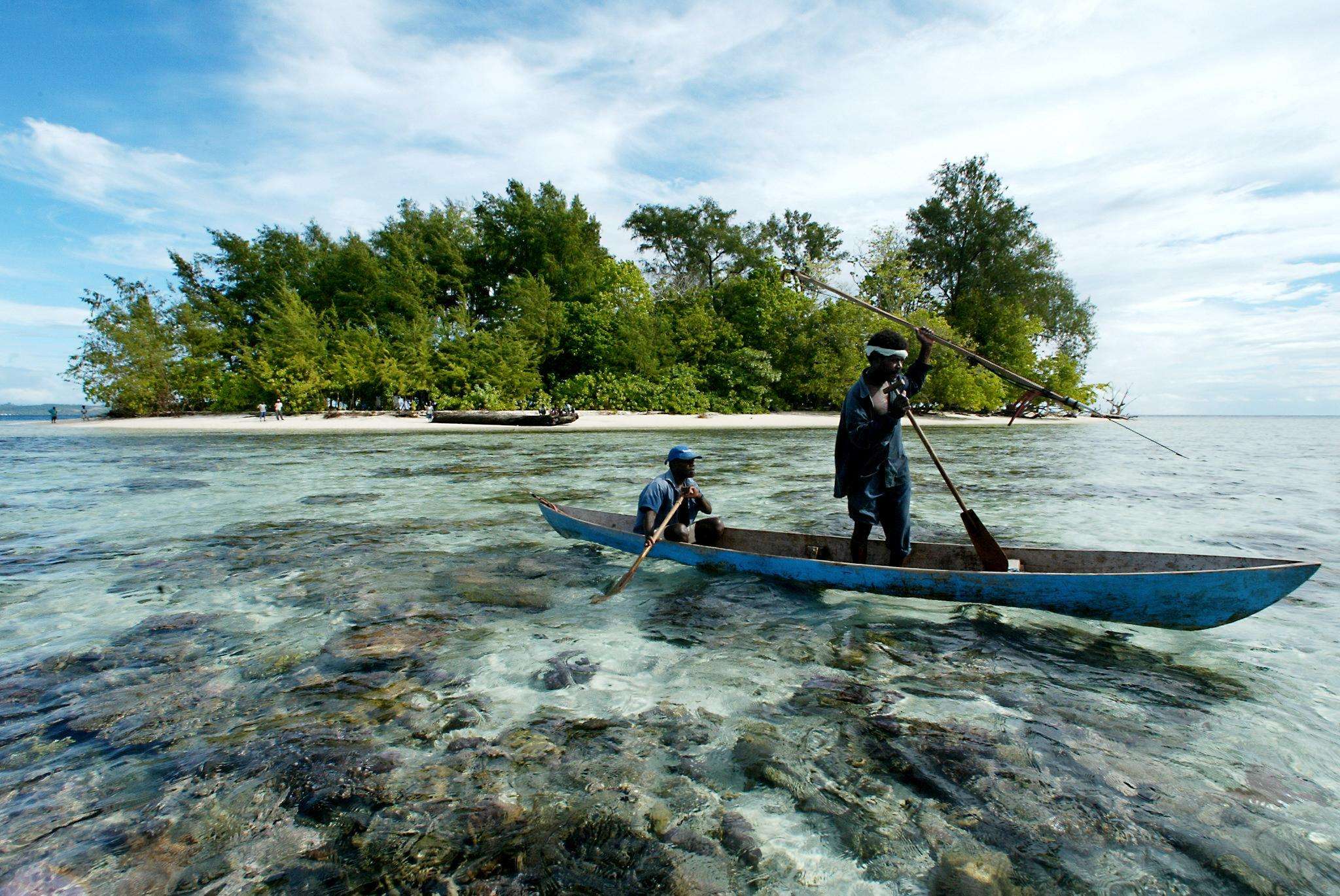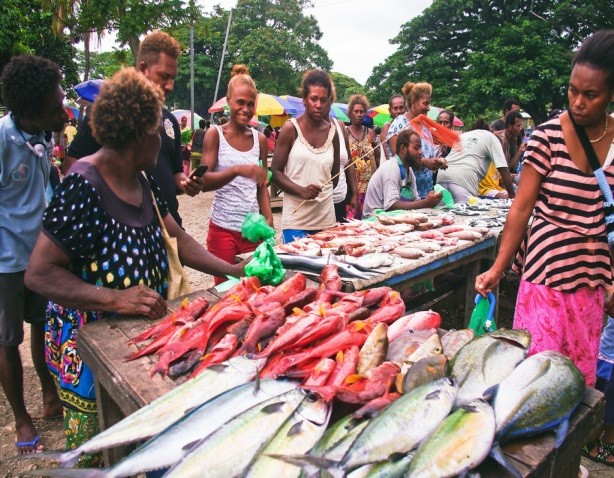One of my biggest
criticisms from my high school is that it seems like we spent a lot of time
studying the American Revolution and the Civil War in history classes. Almost every
single year. Those are important, but I feel like there are huge holes missing
in my US History education. We glossed over topics like prison reform, labor
history, much of the Western expansion (I mean, the taking of what we wanted),
and pretty much all of the 20th century past 1918. WWI was the only major 20th
century event we discussed. And obviously, I've heard of WWII and have watched
movies and shows about it (who HASN'T heard of Hitler? – thanks, History
Channel), but the details of that period are hazy. And here I am, 20 years
after I've graduated from high school, and I'm just now finding out that the
Battle of Guadalcanal (that I knew of in name only) took place in the Solomon
Islands.
Their name (as we know it) was given to them by the Spanish, the first
Europeans to arrive in this area. They named it after King Solomon from the
Bible, falsely thinking these islands had great riches and that the wealthy
city of Ophir was somewhere around there. Boy, were they wrong about that!
Unless you count your wealth in coconuts or sand. As they were transitioning
into independence, they went by "The Solomon Islands" before simply
changing it to "Solomon Islands." As long as they don't start calling
themselves "The Country Formerly Known as Solomon Islands" and change
their name to a symbol, I'm good.
The Solomon Islands are a group of six main islands and 900+ smaller ones east
of Papua New Guinea and northwest of Vanuatu. The Solomon Sea separates Solomon
Islands from PNG while the Coral Sea stands between them and Vanuatu. Traveling
further to the east, Nauru lies northeast and Tuvalu is almost due east from
the Solomon Islands in the South Pacific Ocean. Because of the island's
proximity to the equator, it enjoys a tropical climate all year round. They do
have a rainy season and a drier season. And since they're also located on the
Pacific Rim of Fire, they're also subject to earthquakes: they had one in 2007
that registered 8.1 and one in 2013 that registered at 8.0. That’s a big no
thanks from me.
The earliest people are thought to have come over from Papuan and Austronesian
areas, and later the Polynesians and Lapita people settled there too. The first
Europeans to arrive were the Spanish during the mid-1500s, and Christian missionaries
followed suit during the mid-1800s. Slavery and blackbirding (a new term for
me: basically kidnapping people to make them do manual labor, in this case to work
on their sugar cane plantations) caused the people here to revolt. After the UK
ended their involvement in the slave trade, they counted the southern islands
of the Solomon Islands as one of their protectorates. Over the next decade,
they added a few more islands to the protectorate along with islands that were
part of German New Guinea. The island of Bougainville, which is geographically
part of the Solomon Islands, remained part of German New Guinea, which later became
part of Papua New Guinea. Most of the planters and traders on the islands
escaped to Australia with the onset of WWII. The island of Guadalcanal would be
the location of an integral battle between the Allies and the Japanese. The
next couple of decades after WWII were spent rebuilding their country and
creating a constitution. They officially won their independence in 1978,
although they are still part of the British Commonwealth and pay homage to the
Queen. For about five years around the turn of the 21st century, Solomon
Islands went through a period often called The Tensions (like how the Irish
called theirs The Troubles). This was a time of quite a bit of civil conflicts
between the Isatabu Freedom Movement and the Malaita Eagle Force. It was far
more complicated than just saying it was an ethnic conflict; it rose to
kidnapping government officials and got really ugly there for a while.
Honiara is the capital city, located on the island of Guadalcanal. The airport
nearby was the actual battle location between the US and the Japanese in 1942.
The riots during the early parts of the 2000s destroyed quite a bit of the
city, especially in Chinatown. Today, the city is the center of government,
commerce, transportation, and higher education. It has several museums, sports
stadiums, and arts and music venues that entertain locals and visitors alike.
Most Solomon Islanders work in fishing or agriculture. Tropical timber used to
be a huge export, but when the price fell (not to mention the massive deforestation
they were causing), they looked for other areas of work. Today, copra and palm
oil remain to be major cash crops. There is some mining done in these islands, mainly
gold, zinc, nickel, and lead. Although their currency is the Solomon Islands
dollar, shell money trade, and the barter system can still be found in some of
the more remote islands. A few organizations have come together to develop a
way of getting communities to use renewable energy sources (mainly solar,
water, and wind) without having to put up a bunch of money to get a system in
place. (That would be nice here in the US, too.)
Because of its British and German history, the main religion in the islands is
Christianity, with the Anglican Church of Melanesia being the largest
denomination. There are a number of other Christian denominations represented
in the Solomon Islands, which is followed by nearly 92% of the people. However,
there are also followers of Islam, Baha'i, and indigenous beliefs.
Even though English is the official language, a very small percentage of the
people (around 1-2%) are fluent in it. Instead, you'll find that most people
here speak Solomons Pijin, an English-based creole used as a lingua franca
among the islands. Besides Pijin, Kwara'ae is the largest spoken local
language; there are 70 spoken languages in these islands, and 11 of them have
over 10,000 speakers. Because the islands are so spread out, the language
groups vary. Melanesian languages are generally spoken in the central islands
region, while Polynesian languages are heard on other islands. The i-Kiribati
language, part of the Micronesian language family, is spoken by immigrants from
Kiribati.
Many people associate blonde hair with Celtic, Scandinavian, or other European roots, but the blonde trait has been seen in many Solomon Islanders. Some people thought that perhaps it was due to sun bleaching or even mixing with Europeans, but geneticists have found that's not the case. Researchers found a gene in blonde Solomon Islanders that wasn't in brunette Solomon Islanders -- or in Europeans for that matter. So this study has really led to the need for more studies in genetic pigmentation among variations of other populations (like lighter pigmented Africans, for example). I think it's really cool. Perhaps we aren't who we thought we are.
Up next: art and literature



.jpg)



No comments:
Post a Comment